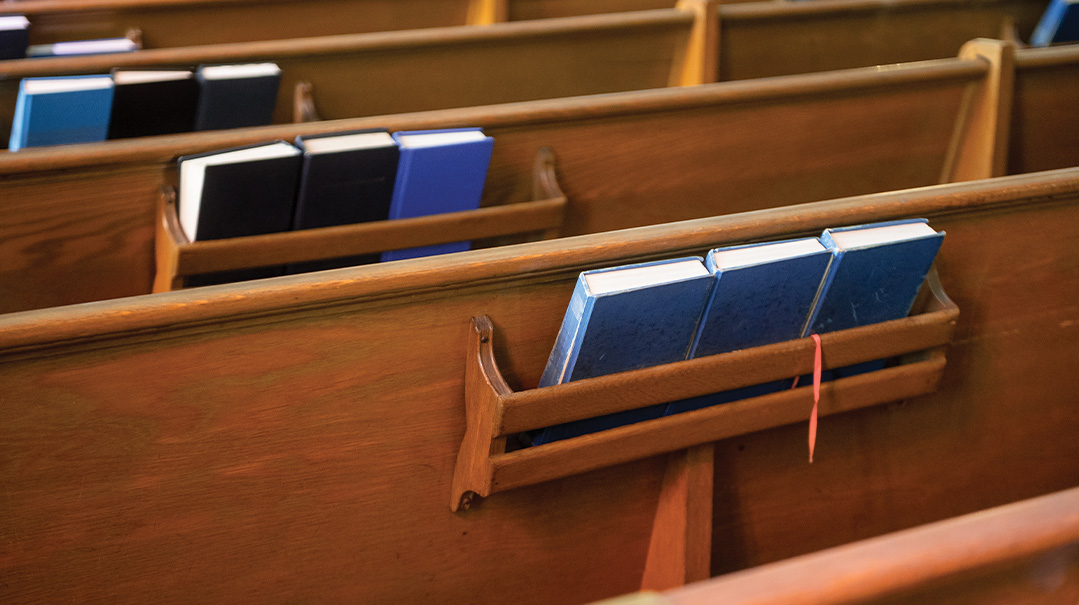Ezras Nashim for One

No one was there, aside from me, and it was just voices on the other side of the curtain, cocooning me in a vision only I could see and feel

Iam not a shul person. Never have been. Of course, I’ve been to shul, but trust me, it was always a social thing.
When I was in shidduchim my mother made me go to shul with her every Shabbos Mevarechim to be “seen.” By whom? I don’t know. I don’t think I fooled anyone with my piety. I’d show up in time for leining, and just follow everyone else standing and sitting.
I’d make an appearance Yamim Noraim, yes, but I was a page counter. I’d also doze off sometimes. Mrs. Berger, who was always seated next to me, was an avid davener; I could always count on her for the right place when I’d finally space back in.
Marriage and my first child were a wonderful respite for me from the pressure of shul. There was no reason to go, not for Yamim Noraim, not for Shabbos Mevarechim. My husband told me I didn’t even have to come for Zachor. I could read it to myself at home. That left only Megillah leining on Purim (if it was in a shul and not someone’s home) and dropping off my kids on Yamim Tovim for Bircas Kohanim.
I was fine with this arrangement. Shul didn’t pull me. I was never a good davener. I didn’t connect with the words, and my kriah was slow. It felt like a chore. When it wasn’t required of me, I let it go. Easily.
I’m getting older though, and while I’m still not the best davener, and my kriah is still slow, I’ve crossed the line from apathy to wanting to want. I want to be able to daven. I see the value, the beauty of sitting in shul, of communing collectively with my Creator. But I have little kids. Who has time to daven in shul?
Then we moved. After the longest wait — there was a time I had doubts if it would ever come to pass — we bought a house. The real estate adage claims that it’s all about Location, Location, Location, and for us it really was. Our new home was down the block from the shul we’ve been members of since its founding, but never lived close enough to attend regularly on Shabbosim.
We moved two weeks before Pesach, and soon enough it was Yom Tov, with its accompanying Bircas Kohanim.
“Come 10:45,” my husband said when I asked when to bring the kids. I dropped off the younger boys (the older ones were already in shul), and with time on my hands and no kids to watch, I decided to go around the back to the ladies’ entrance.
The shul is in a quiet area, in a warehouse-type building; its backyard is train tracks, and there’s an open area for kids to play and to park strollers. It was empty, and I wondered if I’d come too early.
The combination was listed in the classic Jewish format: “Hashem, Imahos, Avos.” I opened the door; the vestibule was dark and quiet. I walked up the industrial steel steps and opened the door to the ezras nashim, pausing for a moment to compose myself before seeing people I didn’t know very well.
It was empty.
I blinked. It was still empty.
Did I have the time wrong? Was there no Bircas Kohanim on Shabbos? (There is, just truncated.) I listened to the men davening, and I definitely heard the chazzan say, “Kohanim.”
There was a siddur on one of the tables. I opened it at random, and it settled on the right page — Bircas Kohanim. There was no one to catch eyes with, to nod at, to give a small smile of hello to. There was no child tugging at my dress asking me to open a candy or get a tissue. There was nothing there to distract me, and so I wasn’t distracted.
I closed my eyes, and let my mind conjure the images of the words, of the scene that was happening just over the mechitzah. The picture quickly vaulted into a vision of a massive gathering in the future that is taking so long to unfurl, but in my mind’s eye, it was there.
And in my real eyes, I felt the tears form. My throat closed with a dry but existential ache I didn’t know I possessed. I’m not one to cry in public. I’ve mastered the art of the yawn to stifle oncoming emotion (try it, it works). But no one was there, aside from me, and it was just voices on the other side of the curtain, cocooning me in a vision only I could see and feel.
It was over sooner than I expected or wanted it to be. The men were now singing Adon Olam, and others were already wishing each other, “Gut Yuntiff” or schmoozing. I felt like I was eavesdropping now. I didn’t belong there anymore.
I left, blinking in the sunlight, and my husband and sons came out soon after.
“Where do you think all the women were?” I wondered. My husband gave an easy shrug.
“It’s a young shul, there aren’t that many men in shul over Yom Tov, most people are still going to their parents for at least the first days.”
That made sense.
I went back for Bircas Kohanim the second days, too, hoping for a repeat of that trance of awe, but as I walked to the back entrance, I saw a woman with girls in matching floral dresses. Upstairs, there were three more women.
I won’t lie; I wasn’t happy to see them.
But I also already had my moment of inspiration. I have the moment to hold on to and come back to whenever I need to remind myself of what I’m doing, and what I’m waiting for.
I live down the block from the shul now. My two-year-old has been going to Minchah on Yom Tov and behaving beautifully.
“You have to be quiet,” he says with his hand in the “shushing” position. I could sneak in a tefillah if I wanted to.
If.
Maybe I’ll become a shul lady one day.
(Originally featured in Family First, Issue 807)
Oops! We could not locate your form.






